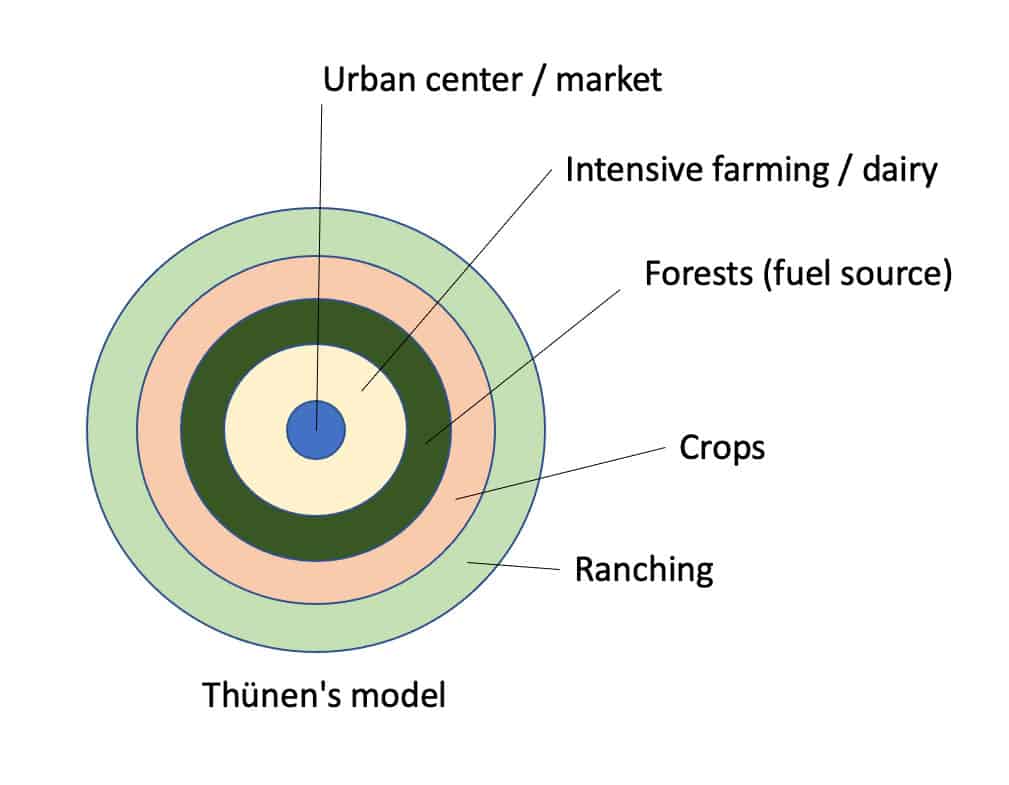Van Thunen theory of land use is an economic model developed by the German economist Johann Heinrich von Thünen in the early 19th century. The theory explains how land use patterns are determined by transportation costs and the relative price of agricultural products.
According to the theory, the most intensively cultivated crops are grown closest to the market, while less intensive crops are grown further away.
The reason for this is that the cost of transportation increases with distance from the market, and so it is more economical to grow less perishable crops further away.
In Van Thunen theory, there are four concentric zones surrounding the market, each with a different land use pattern:
The Inner Zone:
This is the area closest to the market, where the most intensive agriculture is practiced and the most perishable and valuable crops are grown, such as fruits and vegetables.
The Outer Zone:
This is the area beyond the inner zone, where less perishable crops are grown, such as grains and root crops.
The Subsistence Zone:
This is the area beyond the outer zone, where crops are grown for personal consumption rather than for sale at the market.
The Forest Zone:
This is the area furthest from the market, where forests are found.
Van Thunen theory is still widely studied and cited in the field of regional science and geography, and it remains an important tool for understanding the spatial distribution of land use patterns.
However, it should be noted that the model has several limitations, as it assumes a number of idealized conditions, such as a perfectly competitive market and constant transportation costs, that do not always hold in the real world.
Von Thunen theory and Assumptions
Von Thunen’s Model, also known as Von Thunen’s theory of agricultural land use, is a theoretical model that explains the spatial arrangement of different types of agriculture and their respective land use patterns.
This model was developed by the German economist Johann Heinrich von Thunen in the early 19th century.
The main assumptions of Von Thunen theory are:
Perfect Competition:
The model assumes that there are many farmers in the market and they are price-takers. This means that they have no control over the prices of the products they produce.
Isolation:
Von Thunen assumed that the agricultural land is isolated from the rest of the world, which means that there are no transportation costs for goods and labor.
Homogeneous Land:
The model assumes that the agricultural land is homogeneous in terms of quality, fertility, and productivity.
Increasing Transportation Costs:
The model assumes that the transportation costs increase with distance from the market, which influences the type of crops grown and the location of their production.
Land Rent:
Von Thunen assumed that the rent of land decreases as one moves away from the market due to the increasing transportation costs.
Based on these assumptions, Von Thunen’s Model describes the spatial arrangement of different types of agriculture, with the most intensive and high-value crops (such as fruits and vegetables) being grown closest to the market and the less intensive and lower-value crops (such as grains and livestock) being grown further away from the market.
Von Thunen’s Model remains a valuable contribution to the understanding of agricultural land use patterns and continues to be studied and applied in the field of geography and economic geography.
Four Rings of Von Thunen Agricultural Model
The Von Thunen Agricultural Model, also known as the Von Thunen Rings, is an economic theory that explains the distribution of different types of agriculture around a city.
The model is based on the assumption that as the distance from a city increases, the land rent decreases and the cost of transportation increases.
This leads to a pattern of agricultural land use, with different types of crops being grown in different zones around the city.

The four rings of the Von Thunen Agricultural Model are:
The first ring:
This is the closest ring to the city, where the highest quality land is located and the land rent is the highest. The first ring is typically used for growing highly perishable crops, such as fruits and vegetables, that are consumed in the city.
The second ring:
This ring is farther from the city and has lower land rent, but also higher transportation costs. This ring is used for growing crops that are less perishable, such as grains, which can be stored and transported over longer distances.
The third ring:
This ring is even farther from the city, with lower land rent and higher transportation costs. The third ring is used for growing crops that are less perishable and have a lower value, such as livestock feed and forage crops.
The fourth ring:
This is the outermost ring, farthest from the city, and is used for growing crops that are the least perishable and have the lowest value, such as forests and wilderness.
It’s important to note that the Von Thunen Agricultural Model is a theoretical model and does not accurately reflect the complex and dynamic nature of real-world agriculture.
However, it provides a useful framework for understanding the spatial distribution of agricultural land use and its relationship with transportation costs and land rent.
How is the Von Thunen Model used today
The Von Thunen Agricultural Model is still used today as a theoretical framework for understanding the spatial distribution of agricultural land use and its relationship with transportation costs and land rent.
Although the model has its limitations, it provides a useful way to understand how various factors influence the location and type of agriculture in a region.
Here are some of the ways the Von Thunen model is used today:
Agricultural planning and policy-making: The model is used to help policymakers and planners understand the factors that influence the distribution of agriculture in a region and make informed decisions about agricultural development.
Location analysis:
The model is used to evaluate the potential profitability of different agricultural locations based on factors such as transportation costs, land rent, and the type of crops being grown.
Urban and rural development:
The model is used to understand the relationship between urban and rural areas, and how changes in one can affect the other.
Agricultural education:
The model is used in agricultural and economic education to help students understand the basic concepts of agricultural land use, transportation, and land rent.
In recent years, advances in technology and changes in economic and social conditions have challenged the validity of some of the assumptions made by the Von Thunen model.
Nevertheless, it remains an important tool for understanding the spatial distribution of agriculture and its relationship with other factors.
Von Thunen and d’Alonso’s monocentric and polycentric models
Von Thunen’s model is an economic model that describes how the location of agricultural land use is influenced by transportation costs. It was proposed by German economist Johann Heinrich von Thunen in 1826.
According to the model, agricultural land use is arranged in concentric rings around a central market, with the most intensive and perishable crops being grown closest to the market and less intensive and more durable crops being grown further away.
The model assumes that transportation costs are the primary factor influencing land use, with farmers choosing the most profitable crops based on the transportation costs and the market price.
D’Alonso’s model is a spatial model that describes the location of economic activity in urban areas. It was proposed by Italian economist Roberto Camagni and Spanish economist Bernardo d’Alonso in 1978.
According to the model, economic activity is distributed across multiple centers within a city, with each center specializing in a particular type of economic activity.
The model assumes that the location of economic activity is influenced by factors such as transportation costs, land values, and agglomeration economies.
While both Von Thunen’s and d’Alonso’s models deal with the location of economic activity, they are focused on different aspects of the problem.
Von Thunen’s model is primarily concerned with the location of agricultural land use, while d’Alonso’s model is concerned with the location of economic activity in urban areas.
Additionally, while Von Thunen’s model assumes a single central market, d’Alonso’s model assumes multiple centers of economic activity within a city.
Von Thunen’s Critical Analysis
Von Thunen was a 19th-century German economist and landowner who is known for his work in agricultural economics and rural land use.
His most significant contribution to economics was his book, “The Isolated State,” published in 1826, in which he developed a model of land use based on the idea of economic rent.
In his book, Von Thunen developed a model that predicted the pattern of land use in a hypothetical, isolated state. He argued that different types of agriculture would be located at different distances from the center of the state, with the most intensive and profitable uses located closest to the center and less intensive uses located further away.
He also predicted that land rents would decrease as one moved further from the center, as transportation costs would increase and demand for agricultural goods would decrease.
While Von Thunen’s model was groundbreaking in its time, it has been subject to criticism in modern economic theory.
One of the main criticisms is that the model is too simplistic and does not take into account important factors such as the variability of soil quality, topography, and climate, which can significantly impact land use patterns.
Additionally, the model assumes that all land is equally productive, which is not necessarily true in reality.
Another criticism
Another criticism is that the model does not consider the impact of technological change on land use patterns. For example, improvements in transportation technology may reduce the cost of transporting goods, which could affect the location of agricultural activities relative to the center of the state. Similarly, technological advances in agriculture may allow for more intensive land use and higher yields in areas that were previously considered less productive.
Despite these criticisms
Despite these criticisms, Von Thunen’s model remains an important contribution to the study of agricultural economics and land use. His emphasis on the role of transportation costs and the importance of economic rent in determining land use patterns has influenced many subsequent theories of urban and regional economics.

This post on Von Thünen’s agricultural location theory provides such a clear and insightful perspective for UPSC preparations! The way you’ve explained the concentric circles and their relevance to Indian agriculture makes it easier to grasp. It’s fascinating to see how this theory can still apply in today’s context. Thank you for breaking it down so effectively!
This post on Von Thünen’s agricultural location theory is incredibly insightful! The way you explained the rings of land use and their relevance to the economic activities of farmers really clarifies the concept. It’s particularly helpful for us UPSC aspirants to understand how geographical factors influence agricultural practices in India. Thanks for breaking it down so comprehensively!